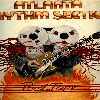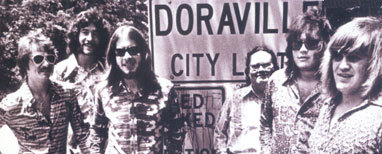|
 "Dog
Days" was ARS's fourth album and their first true masterpiece
- an album that still stands as one of their best. It showcases
a band that has found its groove and is taking its music to a
new level. Featuring another fine collection of songs about themselves
and the South, the band displays a growing array of musical styles
and approaches that are very different from where the rest of
Southern Rock was headed. Overall, it's a faster paced album that
what had come before, featuring six up-tempo songs and two beautiful
ballads-all originals. "Dog
Days" was ARS's fourth album and their first true masterpiece
- an album that still stands as one of their best. It showcases
a band that has found its groove and is taking its music to a
new level. Featuring another fine collection of songs about themselves
and the South, the band displays a growing array of musical styles
and approaches that are very different from where the rest of
Southern Rock was headed. Overall, it's a faster paced album that
what had come before, featuring six up-tempo songs and two beautiful
ballads-all originals.
Despite
the great material, there were no breakout singles or large increases
in national attention. The band continued touring to refined their
live sound, and fairly quickly went back into the studio to record
their next album-one that would capture their evolution in a new
way.
"Red
Tape" - An Early Classic
 Another
early classic that is among their best work, Red Tape is
quite different from the previous album or anything that had come
before. As the band had played more live shows, they had developed
an ensemble sound, and there was an effort to capture that sound
on record. The result was like an ARS gig from the mid-70's-with
a strong emphasis on their appreciation for the blues. The band
had previously been combining pop and rock stylings. For this
album they went with predominantly shorter, pop length songs-with
one notable exception. The performances featured a harder rock
approach than they had recorded before, with a sharp edged guitar
sound prominently featured. Another
early classic that is among their best work, Red Tape is
quite different from the previous album or anything that had come
before. As the band had played more live shows, they had developed
an ensemble sound, and there was an effort to capture that sound
on record. The result was like an ARS gig from the mid-70's-with
a strong emphasis on their appreciation for the blues. The band
had previously been combining pop and rock stylings. For this
album they went with predominantly shorter, pop length songs-with
one notable exception. The performances featured a harder rock
approach than they had recorded before, with a sharp edged guitar
sound prominently featured.
Local
Hits Followed by Pressure from the Record Company to Produce More
Red
Tape was released in April 1976. The first single from the album,
Jukin, was a regional hit and was followed by a second single,
Free Spirit. While these songs got airplay in the South, the album
didn't produce the sales Polydor was looking. They continued to
expand their live performances, including a memorable show in
the spring of 1976 with the Atlanta Symphony Orchestra in Atlanta's
Chastain Park.
ARS
faced increasing pressure for sales and chart success, and this
came to a head in 1976. They had been taking 3 months to record
each album, but now got an ultimatum from their record company-deliver
the next album in 45 days or else. While road weary from touring
non-stop for most of the year, they went back to Studio One and
wrote, recorded, and produced the next album in 30 days. Whether
it was the deadline pressure or the natural evolution of the group,
they created a rock and roll alternative that would carry them
to new heights.
 "A
ROCK AND ROLL ALTERNATIVE" Goes Gold "A
ROCK AND ROLL ALTERNATIVE" Goes Gold
The
band attained a new level of critical acclaim and popular appeal
with this album released in December 1976. It is another eight
song set, including seven originals and a cover of a blues classic
previously recorded by the Yardbirds. While a few songs feature
shorter arrangements similar to the last album, most of the songs
go back to the longer format of previous albums. And while several
of the songs rock hard, overall the production returns to the
smoother, pop feel the band had used to record in the past. This
is another great record-one that seems to be a culmination of
all that ARS had done up to this time. The twin signatures of
the ARS sound - Ronnie Hammond's voice and Barry Bailey's guitar
- have never sounded better, but the record's great strength is
the breadth and scope of the songs themselves.
With
A Rock and Roll Alternative, ARS needed a hit record to keep going-and
they got it. The first single, Neon Nites, got close to the top
40. It was the next single, So Into You, that proved to be the
breakthrough. It rose to number seven on the charts and was a
staple of rock radio during the summer of 1977. The album made
it to the top 10 on the charts and went gold. Popularity carried
them out of the clubs and into stadiums. On Sept. 4, 1977 ARS
played their biggest show yet, the Dog Day Rockfest at Atlanta's
Grant Field on the campus of Georgia Tech University. Heart and
Foreigner were the opening acts and Bob Seger co-headlined. For
a period of several years, ARS was on the road for 250+ shows
a year.
When
they came off the road, they were right back in the studio working
5 days a week. For the first time, the band had popular success
to build on-but this also meant increased expectations to top
themselves. They worked to produce a focused, concept album that
would show they were up to the challenge-and had their greatest
commercial success.
|

